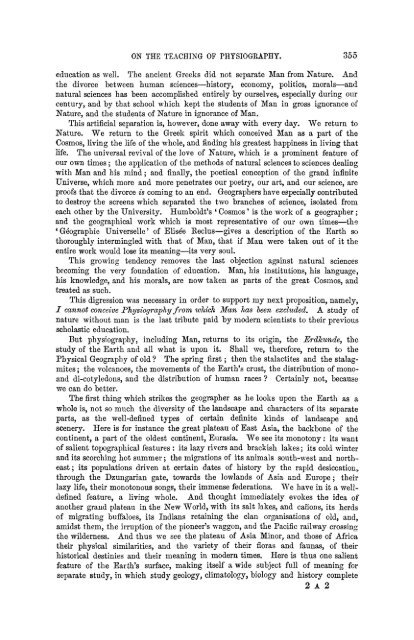On the Teaching of Physiography Author(s): P. Krapotkin Source ...
On the Teaching of Physiography Author(s): P. Krapotkin Source ...
On the Teaching of Physiography Author(s): P. Krapotkin Source ...
You also want an ePaper? Increase the reach of your titles
YUMPU automatically turns print PDFs into web optimized ePapers that Google loves.
ON THE TEACHING OF PHYSIOGRAPHY.355education as well. The ancient Greeks did not separate Man from Nature. And<strong>the</strong> divorce between human sciences-history, economy, politics, morals-andnatural sciences has been accomplished entirely by ourselves, especially during ourcentury, and by that school which kept <strong>the</strong> students <strong>of</strong> Man in gross ignorance <strong>of</strong>Nature, and <strong>the</strong> students <strong>of</strong> Nature in ignorance <strong>of</strong> Man.This artificial separation is, however, done away with every day. We return toNature. We return to <strong>the</strong> Greek spirit which conceived Man as a part <strong>of</strong> <strong>the</strong>Cosmos, living <strong>the</strong> life <strong>of</strong> <strong>the</strong> whole, and finding his greatest happiness in living thatlife. The universal revival <strong>of</strong> <strong>the</strong> love <strong>of</strong> Nature, which is a prominent feature <strong>of</strong>our own times; <strong>the</strong> application <strong>of</strong> <strong>the</strong> methods <strong>of</strong> natural sciences to sciences dealingwith Man and his mind; and finally, <strong>the</strong> poetical conception <strong>of</strong> <strong>the</strong> grand infiniteUniverse, which more and more penetrates our poetry, our art, and our science, arepro<strong>of</strong>s that <strong>the</strong> divorce is coming to an end. Geographers have especially contributedto destroy <strong>the</strong> screens which separated <strong>the</strong> two branches <strong>of</strong> science, isolated fromeach o<strong>the</strong>r by <strong>the</strong> University. Humboldt's ' Cosmos' is <strong>the</strong> work <strong>of</strong> a geographer;and <strong>the</strong> geographical work which is most representative <strong>of</strong> our own times-<strong>the</strong>'Geographie Universelle' <strong>of</strong> Elisee Reclus-gives a description <strong>of</strong> <strong>the</strong> Earth sothoroughly intermingled with that <strong>of</strong> Man, that if Man were taken out <strong>of</strong> it <strong>the</strong>entire work would lose its meaning-its very soul.This growing tendency removes <strong>the</strong> last objection against natural sciencesbecoming <strong>the</strong> very foundation <strong>of</strong> education. Man, his institutions, his language,his knowledge, and his morals, are now taken as parts <strong>of</strong> <strong>the</strong> great Cosmos, andtreated as such.This digression was necessary in order to support my next proposition, namely,I cannot conceive <strong>Physiography</strong> from which Man has been excluded. A study <strong>of</strong>nature without man is <strong>the</strong> last tribute paid by modern scientists to <strong>the</strong>ir previousscholastic education.But physiography, including Man, returns to its origin, <strong>the</strong> Erdkunde, <strong>the</strong>study <strong>of</strong> <strong>the</strong> Earth and all what is upon it. Shall we, <strong>the</strong>refore, return to <strong>the</strong>Physical Geography <strong>of</strong> old ? The spring first; <strong>the</strong>n <strong>the</strong> stalactites and <strong>the</strong> stalagmites;<strong>the</strong> volcanoes, <strong>the</strong> movements <strong>of</strong> <strong>the</strong> Earth's crust, <strong>the</strong> distribution <strong>of</strong> monoanddi-cotyledons, and <strong>the</strong> distribution <strong>of</strong> human races ? Certainly not, becausewe can do better.The first thing which strikes <strong>the</strong> geographer as he looks upon <strong>the</strong> Earth as awhole is, not so much <strong>the</strong> diversity <strong>of</strong> <strong>the</strong> landscape and characters <strong>of</strong> its separateparts, as <strong>the</strong> well-defined types <strong>of</strong> certain definite kinds <strong>of</strong> landscape andscenery. Here is for instance <strong>the</strong> great plateau <strong>of</strong> East Asia, <strong>the</strong> backbone <strong>of</strong> <strong>the</strong>continent, a part <strong>of</strong> <strong>the</strong> oldest continent, Eurasia. We see its monotony: its want<strong>of</strong> salient topographical features: its lazy rivers and brackish lakes; its cold winterand its scorching hot summer; <strong>the</strong> migrations <strong>of</strong> its animals south-west and nor<strong>the</strong>ast;its populations driven at certain dates <strong>of</strong> history by <strong>the</strong> rapid desiccation,through <strong>the</strong> Dzungarian gate, towards <strong>the</strong> lowlands <strong>of</strong> Asia and Europe; <strong>the</strong>irlazy life, <strong>the</strong>ir monotonous songs, <strong>the</strong>ir immense federations. We have in it a welldefinedfeature, a living whole. And thought immediately evokes <strong>the</strong> idea <strong>of</strong>ano<strong>the</strong>r grand plateau in <strong>the</strong> New World, with its salt lakes, and canons, its herds<strong>of</strong> migrating buffaloes, its Indians retaining <strong>the</strong> clan organisations <strong>of</strong> old, and,amidst <strong>the</strong>m, <strong>the</strong> irruption <strong>of</strong> <strong>the</strong> pioneer's waggon, and <strong>the</strong> Pacific railway crossing<strong>the</strong> wilderness. And thus we see <strong>the</strong> plateau <strong>of</strong> Asia Minor, and those <strong>of</strong> Africa<strong>the</strong>ir physical similarities, and <strong>the</strong> variety <strong>of</strong> <strong>the</strong>ir floras and faunas, <strong>of</strong> <strong>the</strong>irhistorical destinies and <strong>the</strong>ir meaning in modern times. Here is thus one salientfeature <strong>of</strong> <strong>the</strong> Earth's surface, making itself a wide subject full <strong>of</strong> meaning forseparate study, in which study geology, climatology, biology and history complete2 A 2














![The Philosophy of Progress [pdf]](https://img.yumpu.com/14077359/1/190x245/the-philosophy-of-progress-pdf.jpg?quality=85)

